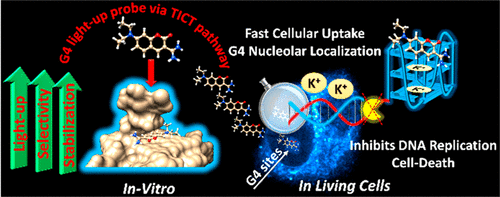当前位置:
X-MOL 学术
›
ACS Chem. Biol.
›
论文详情
Our official English website, www.x-mol.net, welcomes your feedback! (Note: you will need to create a separate account there.)
A Minimalistic Coumarin Turn-On Probe for Selective Recognition of Parallel G-Quadruplex DNA Structures
ACS Chemical Biology ( IF 4 ) Pub Date : 2021-07-30 , DOI: 10.1021/acschembio.1c00134 Marco Deiana 1 , Ikenna Obi 1 , Måns Andreasson 2 , Shanmugam Tamilselvi 1 , Karam Chand 2 , Erik Chorell 2 , Nasim Sabouri 1
ACS Chemical Biology ( IF 4 ) Pub Date : 2021-07-30 , DOI: 10.1021/acschembio.1c00134 Marco Deiana 1 , Ikenna Obi 1 , Måns Andreasson 2 , Shanmugam Tamilselvi 1 , Karam Chand 2 , Erik Chorell 2 , Nasim Sabouri 1
Affiliation

|
G-quadruplex (G4) DNA structures are widespread in the human genome and are implicated in biologically important processes such as telomere maintenance, gene regulation, and DNA replication. Guanine-rich sequences with potential to form G4 structures are prevalent in the promoter regions of oncogenes, and G4 sites are now considered as attractive targets for anticancer therapies. However, there are very few reports of small “druglike” optical G4 reporters that are easily accessible through one-step synthesis and that are capable of discriminating between different G4 topologies. Here, we present a small water-soluble light-up fluorescent probe that features a minimalistic amidinocoumarin-based molecular scaffold that selectively targets parallel G4 structures over antiparallel and non-G4 structures. We showed that this biocompatible ligand is able to selectively stabilize the G4 template resulting in slower DNA synthesis. By tracking individual DNA molecules, we demonstrated that the G4-stabilizing ligand perturbs DNA replication in cancer cells, resulting in decreased cell viability. Moreover, the fast-cellular entry of the probe enabled detection of nucleolar G4 structures in living cells. Finally, insights gained from the structure–activity relationships of the probe suggest the basis for the recognition of parallel G4s, opening up new avenues for the design of new biocompatible G4-specific small molecules for G4-driven theranostic applications.
中文翻译:

用于选择性识别平行 G-四链体 DNA 结构的简约香豆素开启探针
G-四链体 (G4) DNA 结构在人类基因组中广泛存在,并且与端粒维持、基因调控和 DNA 复制等生物学重要过程有关。具有形成 G4 结构潜力的富含鸟嘌呤的序列普遍存在于癌基因的启动子区域,G4 位点现在被认为是抗癌治疗的有吸引力的靶点。然而,很少有关于通过一步合成很容易获得并且能够区分不同 G4 拓扑结构的小型“药物”光学 G4 报告基因的报道。在这里,我们提出了一种小型水溶性发光荧光探针,该探针具有简约的基于脒基香豆素的分子支架,可选择性地靶向平行 G4 结构而不是反平行和非 G4 结构。我们表明这种生物相容性配体能够选择性地稳定 G4 模板,从而导致 DNA 合成变慢。通过跟踪单个 DNA 分子,我们证明了 G4 稳定配体扰乱了癌细胞中的 DNA 复制,导致细胞活力降低。此外,探针的快速进入细胞能够检测活细胞中的核仁 G4 结构。最后,从探针的结构-活性关系中获得的见解为识别平行 G4 奠定了基础,为设计用于 G4 驱动的治疗诊断应用的新型生物相容性 G4 特异性小分子开辟了新途径。我们证明了 G4 稳定配体扰乱了癌细胞中的 DNA 复制,导致细胞活力降低。此外,探针的快速进入细胞能够检测活细胞中的核仁 G4 结构。最后,从探针的结构-活性关系中获得的见解为识别平行 G4 奠定了基础,为设计用于 G4 驱动的治疗诊断应用的新型生物相容性 G4 特异性小分子开辟了新途径。我们证明了 G4 稳定配体扰乱了癌细胞中的 DNA 复制,导致细胞活力降低。此外,探针的快速进入细胞能够检测活细胞中的核仁 G4 结构。最后,从探针的结构-活性关系中获得的见解为识别平行 G4 奠定了基础,为设计用于 G4 驱动的治疗诊断应用的新型生物相容性 G4 特异性小分子开辟了新途径。
更新日期:2021-08-20
中文翻译:

用于选择性识别平行 G-四链体 DNA 结构的简约香豆素开启探针
G-四链体 (G4) DNA 结构在人类基因组中广泛存在,并且与端粒维持、基因调控和 DNA 复制等生物学重要过程有关。具有形成 G4 结构潜力的富含鸟嘌呤的序列普遍存在于癌基因的启动子区域,G4 位点现在被认为是抗癌治疗的有吸引力的靶点。然而,很少有关于通过一步合成很容易获得并且能够区分不同 G4 拓扑结构的小型“药物”光学 G4 报告基因的报道。在这里,我们提出了一种小型水溶性发光荧光探针,该探针具有简约的基于脒基香豆素的分子支架,可选择性地靶向平行 G4 结构而不是反平行和非 G4 结构。我们表明这种生物相容性配体能够选择性地稳定 G4 模板,从而导致 DNA 合成变慢。通过跟踪单个 DNA 分子,我们证明了 G4 稳定配体扰乱了癌细胞中的 DNA 复制,导致细胞活力降低。此外,探针的快速进入细胞能够检测活细胞中的核仁 G4 结构。最后,从探针的结构-活性关系中获得的见解为识别平行 G4 奠定了基础,为设计用于 G4 驱动的治疗诊断应用的新型生物相容性 G4 特异性小分子开辟了新途径。我们证明了 G4 稳定配体扰乱了癌细胞中的 DNA 复制,导致细胞活力降低。此外,探针的快速进入细胞能够检测活细胞中的核仁 G4 结构。最后,从探针的结构-活性关系中获得的见解为识别平行 G4 奠定了基础,为设计用于 G4 驱动的治疗诊断应用的新型生物相容性 G4 特异性小分子开辟了新途径。我们证明了 G4 稳定配体扰乱了癌细胞中的 DNA 复制,导致细胞活力降低。此外,探针的快速进入细胞能够检测活细胞中的核仁 G4 结构。最后,从探针的结构-活性关系中获得的见解为识别平行 G4 奠定了基础,为设计用于 G4 驱动的治疗诊断应用的新型生物相容性 G4 特异性小分子开辟了新途径。



























 京公网安备 11010802027423号
京公网安备 11010802027423号